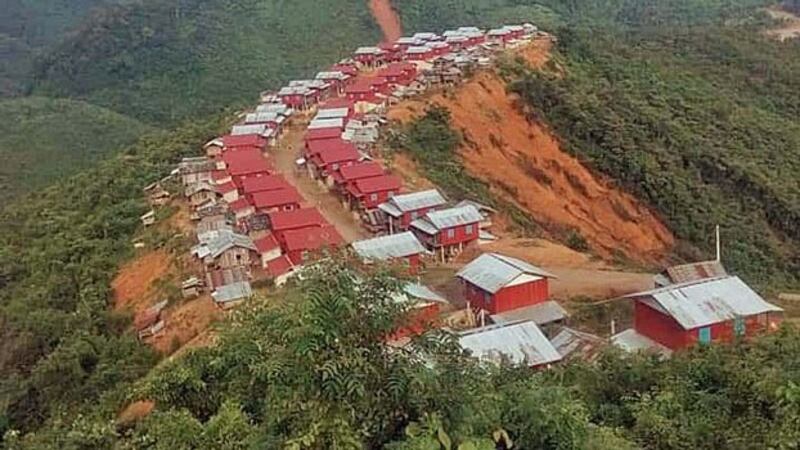Lao villagers displaced by two Chinese-backed dam projects and now living in resettlement communities in uphill areas of two provinces say they fear their new homes will fall off nearby cliffs due to landslides caused by annual monsoonal rains.
Some of the more than 100 families from five villages in Khoua district, Phongsaly province, who moved to the Nam Ou 4 Dam resettlement village five months ago report that the land around their homes has already begun shifting.
“Now, land is sliding down closer and closer to our homes,” said a middle-aged man who moved from Tang Kok village to the Nam Ou 4 Dam village in March. “It’s not even one meter [3.3 feet] from our houses.”
“When it rains, parts of our land will collapse,” he said. “The land is made of soft and porous soil which is not good and not stable for [house] foundations.”
The man, who declined to be named, said the land beneath the villagers’ homes first began shifting in June, and the structures are about to fall off the hill on which they sit.
“We’ve called for help many times, but the company responsible for this resettlement village has never come by and looked at what’s happening,” another resident of the resettlement village said. “The whole village is collapsing. It’s very frightening.”
An official from Khoua district’s Energy and Mines Department, who declined to be named because he is not authorized to speak to media, told RFA that his department will send a team to inspect the situation next week and will contact the company.
Tons of rock
On Thursday, members of a committee responsible for the resettlement of villagers displaced by the Nam Ou 4 Dam project visited the community to examine the land and try to prevent additional slides.
“Some provincial authorities and representatives of the company responsible for the resettlement visited our village and put corrugated metal sheets on the part of the land where the landslide took place to cover up the part that is about to crumble down,” a villager told RFA. “We’re afraid it’s going to collapse again.”
A Khoua district administration official who is a committee member said the company responsible for the homes would lay more stable foundations to replace existing ones as a long-term fix.
By the afternoon, the company had transported tons of rock into the area and advised villagers to lay it on the slope to strengthen it, the villager said.
China’s state-owned hydropower engineering and construction company Sinohydro Corp. began building the Nam Ou 4 Dam in 2016 and planned to complete construction in 2021.
The project is one of seven hydropower dams planned for the Nam Ou River, a tributary of the Mekong River that traverses Phongsaly and Luang Prabang provinces in northern Laos.
The villagers are part of a larger group of 1,400 people from the five villages in Phongsaly’s Khoua district who moved into the resettlement community in mid-March.
Officials gave each family a small concrete house with running water and electricity, a health center, a primary school, and an unpaved road in each village, according to an RFA report in July. They also gave each family U.S. $350- $600 for their property losses and a year’s supply of rice and canned fish.

‘Earth continues to collapse’
Residents of the Nam Tha 1 Dam resettlement village said their community which houses 310 residents in Luang Namtha province’s Nalae district is also on the verge of collapse on account of landslides.
“Oh, we’re worried because our village is on a mountain,” a villager who requested anonymity told RFA in early August. “We don’t know what to do. When it rains, water flows down quickly causing landslides. The authorities have not come to help.”
This resident added that the slope of the mountain where the resettlement village sits began crumbling on July 31 after it had rained for four consecutive days.
“The earth continues to collapse,” the villager said. “It’s now only five meters [16.4 feet] from our homes. Some residents have moved out of the resettlement village and now live temporarily with relatives in other villages.”
An official from the district’s Natural Resources and Environment Department told RFA by email on Aug. 8 that officials cannot reach the area to help the villagers.
“Right now, the road to that village is not accessible at all due to a landslide,” he said. “We discussed the problem yesterday, reported it to the province, and requested that provincial authorities first clear the road, then help the residents of the new village.”
The Nam Tha 1 Dam being built by a subsidiary of the China Southern Power Grid in the mountainous northwest corner of Laos has required the resettlement of more than 10,000 ethnic Lao and minority groups and has impacted downstream communities along the Nam Tha River and the mainstream Mekong.
The company said on its website that it built 11 new sites in which to resettle affected villagers and give them access to roads, water, and electricity.
The dam in Bokeo province, which began commercial operations on April 1, is one of China’s projects in Laos under the Belt and Road Initiative (BRI), the trillion-dollar infrastructure investment and lending program that is a signature policy of Chinese President Xi Jinping.
As with Laos’ other hydropower projects, nearly all of the electricity the Nam Tha 1 Dam produces will be exported.
Impoverished and underdeveloped Laos is undertaking a massive buildout of hydropower projects under the BRI in its rush to become the “battery of Southeast Asia.” But in the process it is becoming ever more financially indebted to China by accepting more and more loans to build the hydropower projects.
Reported by RFA’s Lao Service. Translated by Max Avary. Written in English by Roseanne Gerin.
